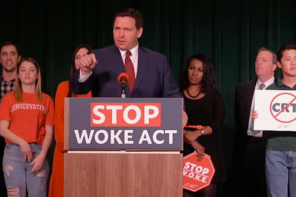Late in December, a dark and solemn quiet falls across the land, as journalists finally begin to reckon with the fact that they’re completely out of gas, and the only thing standing between them a blissful-if-impoverished holiday rest is that one last deadline. Then, quicker than Rudolph making excuses for his day drinking, they leap to that most desperate of ploys: the year-end wrapup.
Religion Dispatches may be immune to this sort of thing, but sadly, I’m not. Therefore, stand by for a link-heavy, in-no-particular-order look back at the year that was. Oh, and how it was!
Billy Graham died in 2018. So did James Cone (a blow to black theology), Eugene Peterson and Aretha Franklin. If you don’t know why the last of those is a religion story, you need to go find her album Amazing Grace and put it on your playlist. Now, please.
As a matter of fact, this whole religion thing? Dead, according to 2018. Young people around the world are disaffiliating from religious faith. Surprisingly or perhaps not, American youngs are leaving evangelical Christianity more quickly than other Christian brands, perhaps because of its full-throated embrace of conservative politics. The trend has been good for at least one segment of the religious ecology, though. The Ex-vangelical movement, in part led by Religion Dispatches contributor Christopher Stroop, has been receiving media attention, including a profile in a CBS news documentary.
The trend was also a godsend (if you will) for one other group. That would be people offering really, really bad hot takes on religion being resurrected as politics. Emma Green published an article in the Atlantic that at least had the dignity to be somewhat better than its title: “Politics as the New Religion for Progressive Democrats.” But Andrew Sullivan’s essay arguing that American Christianity has been replaced by political tribalism is possibly the most obtuse thing he’s ever written—and that’s saying something.
Neither of these takes is willing to struggle with the possibility that there might be good reasons to walk away from the church, even setting aside politics and terrible chili suppers. For example, it was a banner year for stories about clerical sex abuse, what with one cardinal convicted of crimes against children and another revealed to be a predator of young men. Then came the release of a grand jury report from Pennsylvania demonstrating the Catholic hierarchy’s sometimes criminal efforts to sweep bad news under the rug. Then came a follow-up federal investigation, the resignation of Archbishop Donald Wuerl for his part in the cover-up, and the mass resignation of Chilean bishops for the same thing. It was enough to lead Catholic theologian Mary Hunt to wonder whether the entire structure of the church needed to be replaced with something more lay-driven.
The usual malarkey about the rolling abuse crisis being a “gay problem” was rolled out, as were the too-little-too-late promises to shore up reporting. All of this has taken a toll on Pope Francis’ image in the United States, and led the curia’s shadier opportunists to try to support him with a knife to the back in the form of a much-hyped report breathlessly declaring Francis’ complicity in the McCarrick case. (The report was mostly about misplaced memos.) But hey, Francis canonized Oscar Romero, so the year’s not a total waste.
But readers should not come away with the impression that sexual abuse was limited to the Catholic church. Bill Hybels, founder of the pioneering Willow Creek megachurch, was forced out after his pattern of skeevy manipulation and general gross lack of boundaries came to light. Ditto Paige Patterson of the Southern Baptist Convention, thrown out of Southwestern Baptist Theological Seminary for bullying rape victims and being a general disaster on sexual issues. Andy Savage, pastor of Highpoint Church in Memphis, fared a little better. He got a standing ovation from his congregation after confessing to sleeping with a 17-year-old member of his youth group when he was 22. Eventually, though, he resigned, citing a new understanding of his victim’s perspective; which is to say, that she was in fact the victim in this case, not him. It was also revealed that the 2016 Clinton campaign fired its evangelical “faith guru” Burns Strider for sexual harassment of at least two other staffers.
Evangelicals fared only a little better than the Catholic hierarchs in their response. There was a half-assed, single-day conference at Wheaton College, followed by a basic lack of reflection on the theology and sexual ideology that produced these problems in the first place.
Before nonbelievers get too judgy about all of this, though, it should be noted that atheists had their own #MeToo moments this year. David Silverman of American Atheists was fired after being accused of sexual assault; prominent atheist Lawrence Krauss was accused of sexual harassment; and, as Caroline Matas detailed here on RD, New Atheist leaders like Sam Harris and Richard Dawkins supported Men’s Rights activists.
Still, when it comes to bad news, not much comes close to the evangelical world, which consistently finds plenty of squick to go around, even without the sexual abuse. John Allen Chau, a missionary and graduate of Oral Roberts University, tried to evangelize a previously uncontacted and notoriously hostile tribe in the Sentinelese Islands, and was murdered for his efforts. Jeff Sessions tried to defend the grand guignol cruelty of the Trump administration’s immigration policy as part of God’s plan, sparking a questionable effort to impose church discipline on him.
Mike Pence did the generally creepy Mike Pence thing at the Southern Baptist Convention’s annual meeting, albeit it with some reservations on the part of the audience. President Trump, never one to be overshadowed, prayed next to Paula White at a closed-door White House dinner with evangelical leaders and huffed and puffed about challenges to his authority coming in the fall elections. Turns out he was right about the impending disaster at the polls, just not the violent overthrow part. Ah, well. Trump will always have the undying adoration of Robert Jeffress, who stands in a long line of American preachers willing to prop up authoritarianism.
Which points us to the worst sin of the white 2018 evangelical community: forming the white nationalist base of the Trump movement, albeit one that is shrinking fast as its elders die out and youth abandon it. Not even a PR blitz before the fall elections, nor the myth of swing white evangelical women voters, could save the movement from being identified for what it is: Trump’s biggest, meanest cheering section, the people who have historically always been ready to bravely blame somebody else for the problems of life in these United States.
Given conservative evangelical support for—and by “support for” we mean “control over”—the Trump administration, it should come as no surprise that on the subject of religious liberties, the story has been one step forward, two steps back … then another two, and give me three more just for good measure.
First, the good news: A poll this December shows that nonreligious candidates get more support from voters than they have in a long time, beginning to reverse a discriminatory trend in American politics. Other good news? Satanists organized a rally for religious freedom.
Oh, dear. That’s not a lot of good news, is it?
No, it is not. Well, the Supreme Court did rule that an anti-gay breakaway church had to return a cool $500 million to the Episcopal Church in South Carolina. But it also ruled that wedding cake bakers could discriminate against gay couples (or at least escape prosecution for it) if the state hurt their feelings. No, seriously, we wish we were kidding about this, and unfortunately, lower courts were just as bad.
That would be miserable enough, but the court also held that the Trump administration could ban immigration from certain countries essentially because the president feels the need to nail the White House windows shut lest ISIS terrorists or other brown people break in while he’s asleep. “The United States is exclusively shaped by and for white Christians” is about right.
By far the darkest religion story of the year, however, was an anti-Semite’s shooting rampage at the Tree of Life synagogue in Pittsburgh, the deadliest such attack in American history. It was an act of violence deeply rooted in America’s gun idolatry, one that was not so much the past come back to haunt the nation as a reflection of the present danger egged on by a bigot-in-chief willing to embrace anti-Semitic slurs and conspiracy theories. It was made worse by that same administration calling on a pretend rabbi to pray for the victims and by a clueless evangelical establishment toying with the idea that supersessionism maybe wasn’t so bad after all.
If there was any ray of light in this dark year—anything that could give you faith in humanity, if not God—it was the response of the community to the Tree of Life violence, an interfaith prayer service held in Mr. Roger’s church, preceded by a quiet, reflective protest informing the bigot-in-chief that he was not welcome to share Squirrel Hill’s grief. More generally, there was the rise of the Never Again movement, led by survivors of a mass school shooting in Parkland, Florida, who offered hope that things might, even for a minute, be different. If we at Religion Dispatches have any wishes for the coming year, it’s that their efforts and the blood of the victims not be wasted. Be better, 2019, be best!




